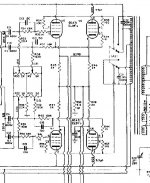Hello. I'm new hear and this is my first post.
This is the o/p circuit of my old Unicox U1511. It is different than any similar Marshall or Ampeg 150 watt amp I have ever seen. Can anyone comment on why the second pair of tubes has the plate resistors and also the 1.5K resistor on the grids??
This is the o/p circuit of my old Unicox U1511. It is different than any similar Marshall or Ampeg 150 watt amp I have ever seen. Can anyone comment on why the second pair of tubes has the plate resistors and also the 1.5K resistor on the grids??
Attachments
the resistors are there to supress the extreme high frequencies,[parasitic ocilations] this is usually done on high frequency beam tetrodes like the 807 tube, but sometimes is necesary on 6550/kt88 depending on the circuit used, and its aplication.
v-man...😉
v-man...😉
Thanx for the reply V-Man.
Are you referring to the plate resistors or the grid resistors or both?
I wonder why these oscillations are an issue with my Univox amp but not on a 6550'd Marshall or Ampeg?
thanx
stew
Are you referring to the plate resistors or the grid resistors or both?
I wonder why these oscillations are an issue with my Univox amp but not on a 6550'd Marshall or Ampeg?
thanx
stew
hi stew,
the both resistors are used for said reason,this has been done[probably] in this amp because of the way the output tubes are biased,eg, class AB, and also maybe due to the type of output transformers used. i am a bit concerned that this has only been done on two output tubes though. or have i missunderstood.
v-man...
the both resistors are used for said reason,this has been done[probably] in this amp because of the way the output tubes are biased,eg, class AB, and also maybe due to the type of output transformers used. i am a bit concerned that this has only been done on two output tubes though. or have i missunderstood.
v-man...
I'm rather surprised to see those resistors on just one pair of tubes. It is possible (just speculating!) that these were necessary because of some layout considerations- perhaps the leads to the second set of tubes were longer, so the designer felt that parasitic suppression resistors were only needed for that pair of tubes. There would be no harm (other than a few pennies in extra cost) in having parasitic suppression resistors on all the o/p tubes.
Thanks to everyone.
Perhaps SY has hit the nail on the head. The transformer has very short leads connected to the first set of tubes, the second set (with the resistors) is a few inches further away.
If you gents care to carry on with this thread, why did the designer go with a single cathode bias resistor instead of individuals. As a matter of fact I see a lot of guitar amps with 6550s have their cathodes connected directly to ground.
thanx again
stew
Perhaps SY has hit the nail on the head. The transformer has very short leads connected to the first set of tubes, the second set (with the resistors) is a few inches further away.
If you gents care to carry on with this thread, why did the designer go with a single cathode bias resistor instead of individuals. As a matter of fact I see a lot of guitar amps with 6550s have their cathodes connected directly to ground.
thanx again
stew
If the cathode is tied directly to ground, the amp needs to have a negative rail to bias the grids.
Why one cathode resistor versus two can be a complicated story, but one thing's for sure- it's cheaper.
Why one cathode resistor versus two can be a complicated story, but one thing's for sure- it's cheaper.
Hi,
That's really very common for guitar amps.
It allows biasing the tubes in such a way that they can be driven to distort to yield a particular sound.
It also makes it easier when putting in a new pair of tubes: a tightly matched set isn't really mandatory as the individual bias allows for more compensation than cathode bias would.
Up to a point at least...
The resistors (or chokes) on the anode/plate serve the same task as gridstopper resistors: they're there to prevent spontaneous self-oscillations.
Hence the name anodestoppers or platestoppers.
Cheers,😉
As a matter of fact I see a lot of guitar amps with 6550s have their cathodes connected directly to ground.
That's really very common for guitar amps.
It allows biasing the tubes in such a way that they can be driven to distort to yield a particular sound.
It also makes it easier when putting in a new pair of tubes: a tightly matched set isn't really mandatory as the individual bias allows for more compensation than cathode bias would.
Up to a point at least...
The transformer has very short leads connected to the first set of tubes, the second set (with the resistors) is a few inches further away.
The resistors (or chokes) on the anode/plate serve the same task as gridstopper resistors: they're there to prevent spontaneous self-oscillations.
Hence the name anodestoppers or platestoppers.
Cheers,😉
- Status
- Not open for further replies.
- Home
- Amplifiers
- Tubes / Valves
- 6550 o/p stage

